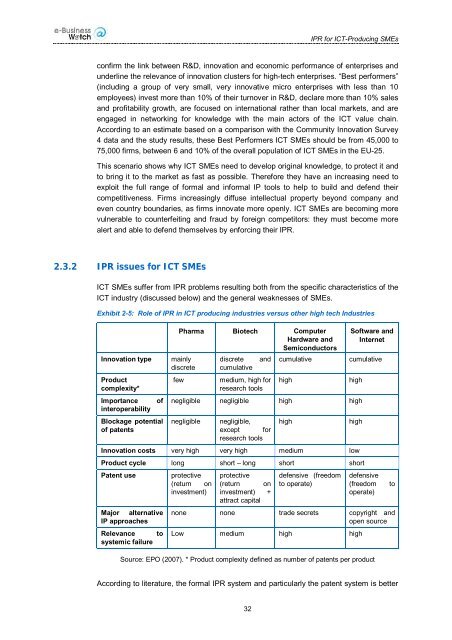IPR for ICT-Producing SMEs2.3.1 ICT SMEs, <strong>Competitiveness</strong> <strong>and</strong> the Role of IPRToday more than ever, ICT SMEs must keep pace with the relentless pace of innovation<strong>and</strong> globalization. IPR management is an essential element of SMEs innovationstrategies. In order to analyze it, we must underst<strong>and</strong> better the main challenges faced byICT SMEs.The ICT sector grows faster than Europe's overall economy, particularly the software <strong>and</strong>IT services industry, according to the i2010 third annual report 18 . However, the overalltrade performance of the EU in ICT goods is unsatisfactory. In 2006, it reported a €77.5billion trade deficit, including €48.3 billion in computers, €20.9 billion in audio <strong>and</strong> videoequipment <strong>and</strong> €14 billion in electronic components. The main threats for the EU ICTindustry originate in the increasing competition by emerging economies in Asia (China,India), in the possible expansion of US dominance in computing, <strong>and</strong> in a lack of useracceptance <strong>and</strong> uptake of new technology within the EU economy.In this scenario, ICT SMEs must deal with increasing international competition, keep upwith the pace of technological innovation, which is heating up again, <strong>and</strong> adapt to thereorganization of world supply chains. Moreover, ICT SMEs cannot afford any more tofocus only on local markets, as the push of globalization is increasing trade openness,forcing greater specialization <strong>and</strong> the elimination of less efficient firms 19 .The new technological cycle of the ICT industry is driven by digital convergence <strong>and</strong> thecomplete diffusion of the Internet as the main architectural network, launching a newwave of applications under the label of the so-called Web 2.0 or social computing. Thesoftware industry is undergoing a deep transformation process. In order to respond tocustomers needs to deal with IT complexity <strong>and</strong> infrastructure optimization, new businessmodels are emerging, characterized by greater service content (“software as a service”)<strong>and</strong> ever closer interaction with customers. This requires investments in R&D <strong>and</strong>innovation, as well as continuous skills upgrading. <strong>European</strong> markets fragmentation <strong>and</strong>still insufficient investments in ICT research <strong>and</strong> new skills are weaknesses affectingespecially ICT SMEs. Both the EU <strong>Competitiveness</strong> Report <strong>and</strong> the ICT Task ForceReport underline that raising research investments of the EU ICT sector is essential,particularly by ICT SMEs.According to the 2007 EU <strong>Competitiveness</strong> Report, the general trend across Europe isthe emergence of global value networks led by the most successful enterprises, who willintegrate planning, marketing <strong>and</strong> R&D services, subcomponents <strong>and</strong> customer servicesby many different actors. This will lead to more complex organizational approaches, witha high degree of collaboration <strong>and</strong> networking between suppliers, customers, competitors<strong>and</strong> external sources of knowledge such as research institutions <strong>and</strong> universities. Thebest performers among innovative ICT SMEs are adapting to this model to survive,finding valuable roles within the emerging value chains, especially if they becomespecialized niche leaders.ICT SMEs are highly innovative. According to a study carried out by IDC EMEA for DGINFSO, based on an original survey, innovative ICT SMEs in the EU-25 areapproximately 300,000, that is about 41% of the universe. The results of the study1819i2010 - Annual Information Society Report 2008, Commission Communication, Brussels,17.04.2008, COM(2007) 146 final<strong>European</strong> <strong>Competitiveness</strong> Report 2007, Communication from the Commission, 31,10,2007,COM (2007) 666.31
IPR for ICT-Producing SMEsconfirm the link between R&D, innovation <strong>and</strong> economic performance of enterprises <strong>and</strong>underline the relevance of innovation clusters for high-tech enterprises. “Best performers”(including a group of very small, very innovative micro enterprises with less than 10employees) invest more than 10% of their turnover in R&D, declare more than 10% sales<strong>and</strong> profitability growth, are focused on international rather than local markets, <strong>and</strong> areengaged in networking for knowledge with the main actors of the ICT value chain.According to an estimate based on a comparison with the Community Innovation Survey4 data <strong>and</strong> the study results, these Best Performers ICT SMEs should be from 45,000 to75,000 firms, between 6 <strong>and</strong> 10% of the overall population of ICT SMEs in the EU-25.This scenario shows why ICT SMEs need to develop original knowledge, to protect it <strong>and</strong>to bring it to the market as fast as possible. Therefore they have an increasing need toexploit the full range of formal <strong>and</strong> informal IP tools to help to build <strong>and</strong> defend theircompetitiveness. Firms increasingly diffuse intellectual property beyond company <strong>and</strong>even country boundaries, as firms innovate more openly. ICT SMEs are becoming morevulnerable to counterfeiting <strong>and</strong> fraud by foreign competitors: they must become morealert <strong>and</strong> able to defend themselves by enforcing their IPR.2.3.2 IPR issues for ICT SMEsICT SMEs suffer from IPR problems resulting both from the specific characteristics of theICT industry (discussed below) <strong>and</strong> the general weaknesses of SMEs.Exhibit 2-5: Role of IPR in ICT producing industries versus other high tech IndustriesInnovation typeProductcomplexity*ImportanceinteroperabilityofBlockage potentialof patentsPharma Biotech ComputerHardware <strong>and</strong>Semiconductorsmainlydiscretefewdiscretecumulative<strong>and</strong>medium, high forresearch toolscumulativehighSoftware <strong>and</strong>Internetcumulativehighnegligible negligible high highnegligiblenegligible,except forresearch toolshighInnovation costs very high very high medium lowProduct cycle long short – long short shortPatent useMajor alternativeIP approachesRelevance tosystemic failureprotective(return oninvestment)protective(return oninvestment) +attract capitaldefensive (freedomto operate)highdefensive(freedomoperate)none none trade secrets copyright <strong>and</strong>open sourceLow medium high highSource: EPO (2007). * Product complexity defined as number of patents per producttoAccording to literature, the formal IPR system <strong>and</strong> particularly the patent system is better32
















